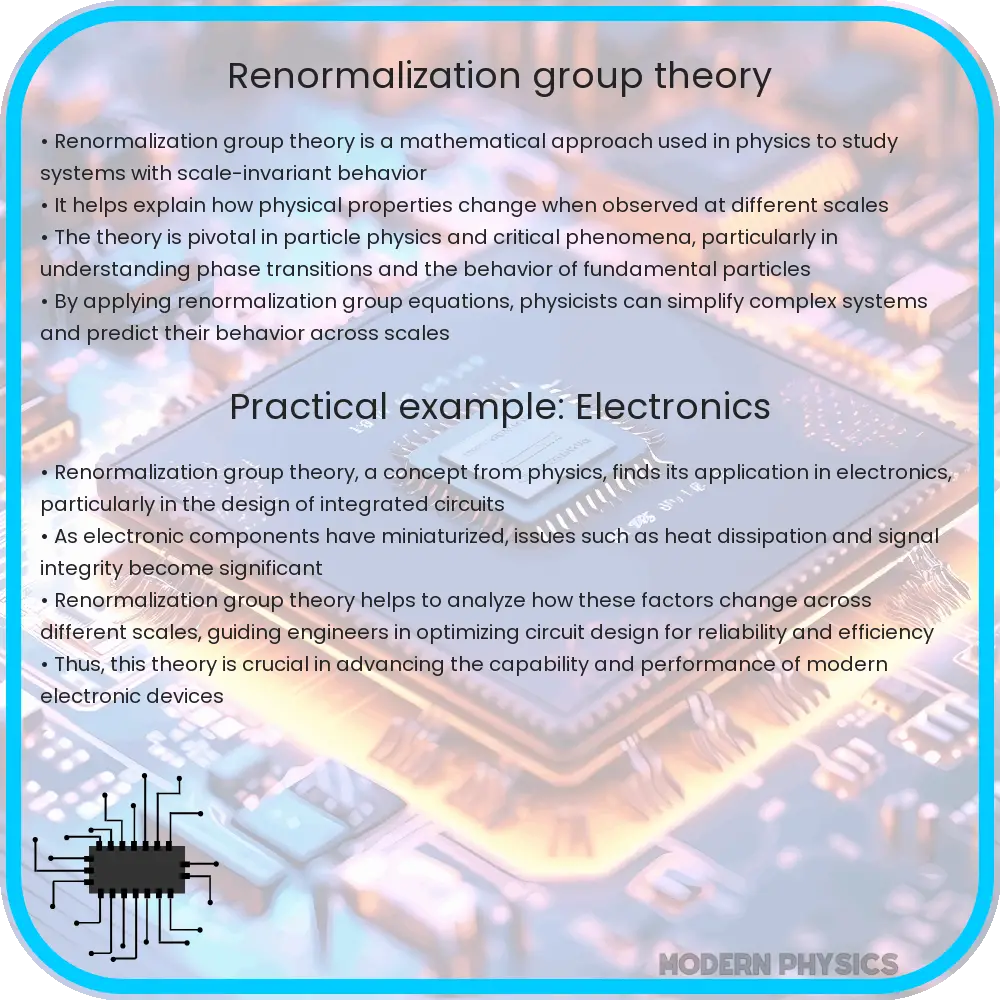Explore the essentials of Renormalization Group Theory in quantum physics, its impact on particle physics, and future research directions.

Understanding Renormalization Group Theory in Quantum Physics
The concept of Renormalization Group Theory (RGT) plays a pivotal role in our understanding of quantum physics, particularly in the realms of particle physics and statistical mechanics. It serves as a bridge connecting the microcosmic quantum world with the macroscopic phenomena we observe. The theory provides a framework for understanding how physical systems behave when observed at different scales, and it offers insights into the fundamental nature of forces and particles.
Quantum Insights from Renormalization Group Theory
At the heart of RGT is the idea that the laws of physics can display different characteristics at different scales. This is crucial in quantum field theory, where phenomena like the running of coupling constants are observed. The coupling constant, denoted as α, changes with energy scale. For instance, in quantum electrodynamics (QED), the electromagnetic coupling constant α increases as the energy scale goes up, reflecting the complex vacuum structure of QED. The mathematical toolset of RGT allows physicists to systematically study these changes.
Applications of Renormalization Group Theory
RGT has profound applications in various fields of physics. In particle physics, it helps in understanding the behavior of fundamental forces under different energy conditions. The theory is also essential in condensed matter physics, offering insights into phase transitions and critical phenomena. For example, near a critical point, systems exhibit scale invariance, and RGT provides a framework to analyze these transitions.
- Particle Physics: RGT explains why the strong nuclear force becomes weaker at high energies (asymptotic freedom), a key concept in quantum chromodynamics (QCD).
- Statistical Mechanics: It elucidates how macroscopic properties emerge from microscopic interactions, particularly near phase transitions.
In summary, Renormalization Group Theory is a fundamental concept in modern physics that offers quantum insights and has wide-ranging applications across various domains. Its ability to connect different scales of observation makes it a powerful tool in understanding the intricate nature of the universe.
Deeper Dive into Renormalization Group Theory
Delving deeper into Renormalization Group Theory, it becomes evident that the approach is not just about observing physical phenomena at different scales, but it is fundamentally about understanding the dynamics of scale changes. This process involves the mathematical concept of ‘scaling transformations,’ which are at the core of renormalization. By analyzing how physical quantities transform under these scaling operations, physicists can understand the behavior of systems ranging from subatomic particles to large-scale statistical systems.
One of the remarkable outcomes of RGT is the concept of ‘fixed points.’ In the context of phase transitions, a fixed point is a set of conditions where the system shows scale invariance. The critical exponents, which describe the behavior of physical quantities near critical points, can be derived using RGT. These exponents have universal properties, meaning they are the same for a wide class of different systems, demonstrating the unifying power of renormalization group methods.
Implications and Future Directions
Renormalization Group Theory has significantly impacted our understanding of the natural world. Its implications extend beyond theoretical physics, influencing fields like cosmology, materials science, and even biology. In cosmology, RGT concepts help in understanding the large-scale structure of the universe, while in materials science, they are used to study the properties of novel materials.
Future research in RGT is expected to continue unveiling deeper insights into quantum field theories, particularly in unexplored high-energy regimes. This could lead to breakthroughs in our understanding of fundamental forces and the development of new theories beyond the Standard Model of particle physics.
Conclusion
In conclusion, Renormalization Group Theory stands as a cornerstone in the edifice of modern physics. Its ability to provide a coherent framework for understanding physical phenomena across different scales has revolutionized our perception of the universe. From the intricacies of quantum fields to the mysteries of cosmic structures, RGT continues to offer profound insights and remains an essential tool in the physicist’s toolkit. As research progresses, the theory is poised to further bridge the gap between known physics and uncharted territories, promising new discoveries and deeper understanding of the cosmos.
